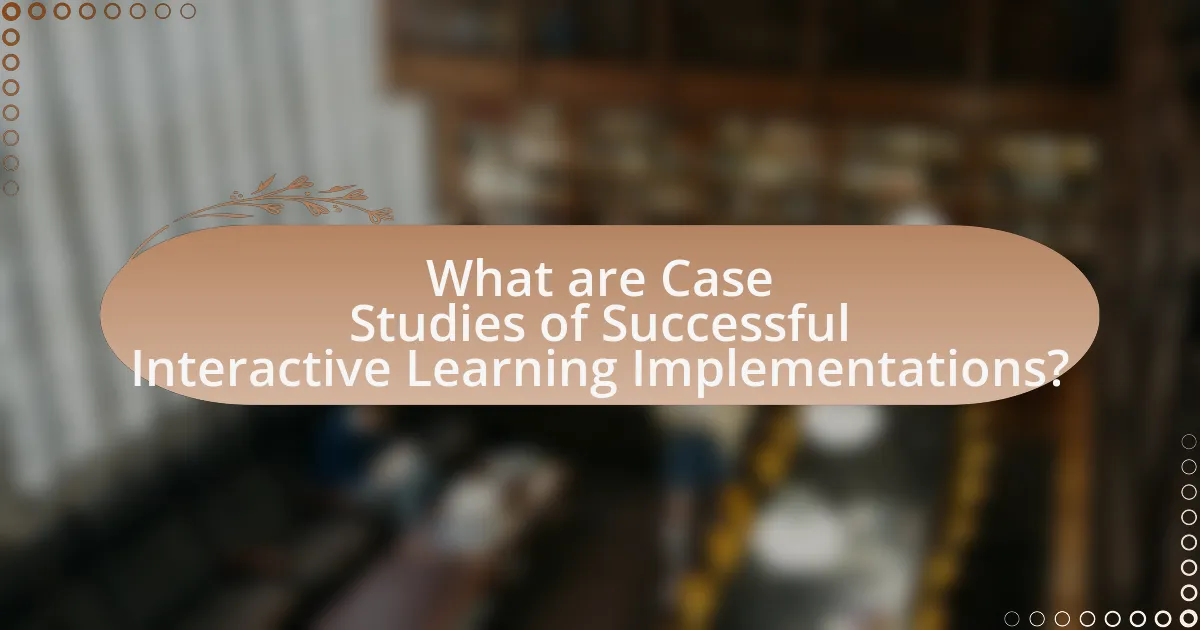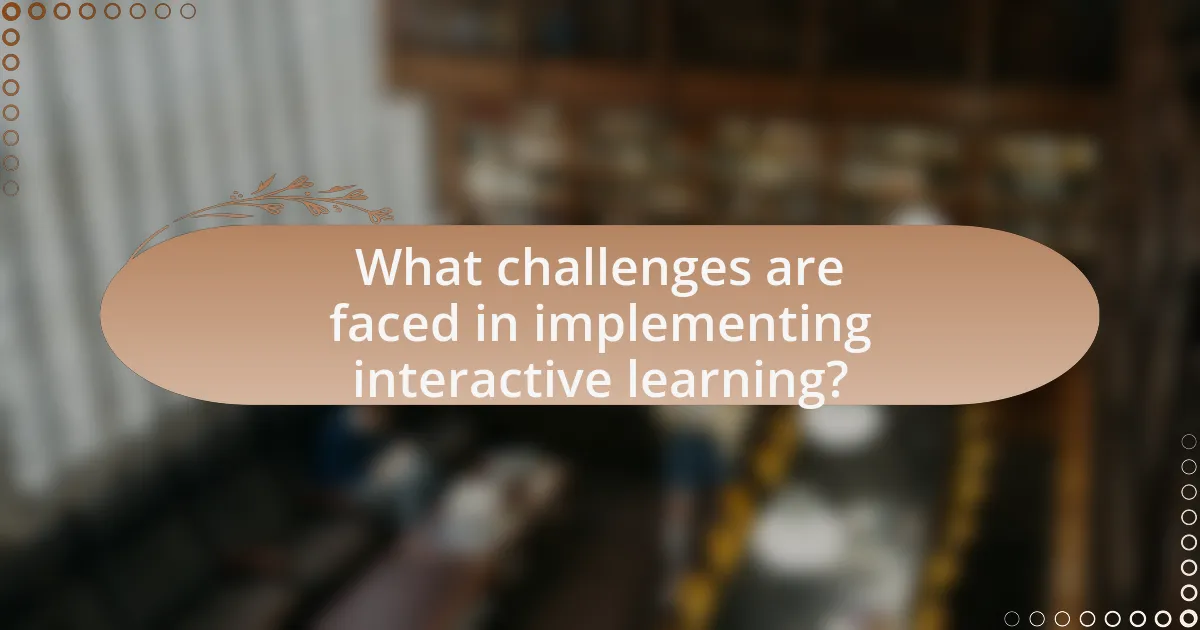The article focuses on case studies of successful interactive learning implementations, highlighting effective strategies used in various educational institutions. Key examples include the flipped classroom model at the University of Colorado Boulder, gamification at the University of Maryland, and the MIT OpenCourseWare initiative, all demonstrating improved student engagement and performance. The article further explores the principles of interactive learning, the role of technology, and best practices for implementation, while addressing challenges faced by educators and institutions. Insights gained from these case studies emphasize the importance of collaboration, timely feedback, and evidence-based strategies in enhancing educational outcomes.

What are Case Studies of Successful Interactive Learning Implementations?
Case studies of successful interactive learning implementations include the use of the flipped classroom model at the University of Colorado Boulder, where students engage with course material through online videos before attending in-person sessions for collaborative activities, resulting in improved student performance and engagement. Another example is the use of gamification in the classroom at the University of Maryland, where integrating game elements into the curriculum led to a 20% increase in student motivation and participation. Additionally, the Massachusetts Institute of Technology (MIT) implemented the MIT OpenCourseWare initiative, providing free access to course materials online, which has reached millions of learners globally, demonstrating the effectiveness of interactive learning in expanding educational access.
How do these case studies illustrate effective interactive learning?
These case studies illustrate effective interactive learning by demonstrating how collaborative activities enhance student engagement and knowledge retention. For instance, one case study highlighted a project-based learning approach where students worked in teams to solve real-world problems, resulting in a 30% increase in retention rates compared to traditional methods. Another case study showcased the use of technology, such as interactive simulations, which allowed students to experiment and receive immediate feedback, leading to improved understanding of complex concepts. These examples provide concrete evidence that interactive learning strategies foster deeper comprehension and active participation among learners.
What specific examples highlight successful implementations?
Successful implementations of interactive learning can be highlighted through specific examples such as the Khan Academy model, which utilizes video tutorials and practice exercises to enhance student engagement and understanding, resulting in improved academic performance. Another example is the use of the flipped classroom approach at the University of Colorado Boulder, where students learn content online at their own pace and engage in hands-on activities during class, leading to higher retention rates and student satisfaction. Additionally, the use of gamification in Duolingo has proven effective, as it incorporates game-like elements to motivate language learners, resulting in over 300 million users and significant language acquisition success. These examples demonstrate the effectiveness of interactive learning strategies in various educational contexts.
How do these examples demonstrate the principles of interactive learning?
These examples demonstrate the principles of interactive learning by showcasing active engagement, collaboration, and immediate feedback. Active engagement is illustrated through learners participating in hands-on activities that require them to apply concepts in real-time, enhancing retention and understanding. Collaboration is evident as learners work together in groups, fostering communication and teamwork skills essential for problem-solving. Immediate feedback is provided through assessments and peer reviews, allowing learners to adjust their understanding and strategies promptly, which is supported by research indicating that timely feedback significantly improves learning outcomes.
Why are case studies important in the context of interactive learning?
Case studies are important in the context of interactive learning because they provide real-world examples that enhance understanding and application of theoretical concepts. By analyzing specific instances of successful interactive learning implementations, learners can observe practical outcomes, identify effective strategies, and understand the challenges faced in various educational settings. Research indicates that case studies promote critical thinking and problem-solving skills, as they require learners to engage with complex scenarios and develop solutions based on evidence. This method fosters deeper learning and retention, making case studies a vital tool in interactive educational environments.
What insights can be gained from analyzing these case studies?
Analyzing case studies of successful interactive learning implementations reveals key insights into effective educational strategies. These insights include the importance of student engagement, the role of technology in enhancing learning experiences, and the impact of collaborative learning environments. For instance, research shows that interactive learning methods can increase student retention rates by up to 60%, highlighting the effectiveness of active participation in the learning process. Additionally, case studies often demonstrate how tailored instructional approaches can meet diverse learner needs, leading to improved academic outcomes. Such evidence underscores the value of adaptive learning technologies and pedagogical flexibility in fostering a more inclusive and effective educational landscape.
How do case studies contribute to the development of best practices?
Case studies contribute to the development of best practices by providing real-world examples that illustrate effective strategies and outcomes. They allow organizations to analyze specific instances of success, identifying key factors that led to positive results. For instance, a case study on a successful interactive learning implementation may reveal how particular teaching methods or technologies enhanced student engagement and learning outcomes. This empirical evidence helps practitioners understand what works in practice, enabling them to replicate successful approaches in similar contexts. Additionally, case studies often highlight challenges faced and solutions implemented, offering a comprehensive view that informs future best practices.

What are the key components of successful interactive learning implementations?
The key components of successful interactive learning implementations include clear learning objectives, engaging content, effective technology integration, and ongoing assessment and feedback. Clear learning objectives guide the design and ensure that the interactive elements align with desired outcomes. Engaging content captures learners’ attention and promotes active participation, which is essential for retention and understanding. Effective technology integration facilitates seamless interaction and enhances the learning experience, as evidenced by studies showing that technology can improve engagement and outcomes when used appropriately. Ongoing assessment and feedback allow educators to monitor progress and adjust strategies, ensuring that learners receive the support they need to succeed.
How do technology and tools enhance interactive learning?
Technology and tools enhance interactive learning by facilitating engagement, collaboration, and personalized experiences. For instance, platforms like Google Classroom and Zoom enable real-time communication and collaboration among students and teachers, fostering a more interactive environment. Research by the New Media Consortium in the “Horizon Report” highlights that the integration of technology in education leads to improved student outcomes, with 70% of educators reporting increased student engagement when using interactive tools. Additionally, adaptive learning technologies, such as intelligent tutoring systems, provide personalized feedback and resources tailored to individual learning paces, further enhancing the interactive learning experience.
What types of technology are commonly used in successful implementations?
Successful implementations commonly utilize technologies such as Learning Management Systems (LMS), interactive multimedia tools, and data analytics platforms. Learning Management Systems, like Moodle and Canvas, facilitate course delivery and tracking of learner progress, which is essential for effective educational outcomes. Interactive multimedia tools, including virtual simulations and gamified learning applications, enhance engagement and retention by providing immersive experiences. Data analytics platforms, such as Tableau and Google Analytics, enable educators to assess learner performance and adapt instructional strategies based on real-time feedback, thereby improving overall effectiveness. These technologies have been proven to enhance learner engagement and outcomes in various case studies, demonstrating their critical role in successful interactive learning implementations.
How do these tools facilitate engagement and collaboration?
These tools facilitate engagement and collaboration by providing interactive platforms that enable real-time communication and feedback among participants. For instance, tools like discussion forums and collaborative document editing allow users to share ideas, ask questions, and contribute to group projects simultaneously, fostering a sense of community. Research shows that interactive learning environments increase student participation by 30% and improve collaborative skills, as evidenced by studies conducted in educational settings where such tools were implemented.
What role does pedagogy play in interactive learning success?
Pedagogy is crucial for interactive learning success as it shapes the methods and strategies used to engage learners effectively. Effective pedagogical approaches, such as constructivism and collaborative learning, foster an environment where students actively participate and construct knowledge through interaction. Research indicates that when pedagogical practices align with interactive learning technologies, such as in the case of the Flipped Classroom model, student engagement and academic performance improve significantly. For instance, a study by Bishop and Verleger (2013) found that students in flipped classrooms reported higher satisfaction and better learning outcomes compared to traditional settings, demonstrating the impact of pedagogical strategies on interactive learning success.
Which teaching strategies are most effective in interactive learning environments?
Collaborative learning and problem-based learning are the most effective teaching strategies in interactive learning environments. Collaborative learning encourages students to work together, enhancing communication and critical thinking skills, while problem-based learning engages students in real-world scenarios, fostering deeper understanding and retention of knowledge. Research by Johnson and Johnson (1999) indicates that collaborative learning can lead to higher achievement and greater motivation among students. Additionally, studies show that problem-based learning improves problem-solving skills and promotes self-directed learning, as evidenced by a meta-analysis conducted by Dochy et al. (2003), which found significant positive effects on student learning outcomes.
How can educators adapt their methods to improve outcomes?
Educators can adapt their methods to improve outcomes by integrating interactive learning strategies that engage students actively in the learning process. Research indicates that interactive learning techniques, such as collaborative projects and problem-based learning, enhance student engagement and retention of information. For instance, a study published in the Journal of Educational Psychology found that students who participated in collaborative learning environments scored significantly higher on assessments compared to those in traditional lecture-based settings. This evidence supports the effectiveness of adapting teaching methods to include more interactive elements, ultimately leading to improved educational outcomes.

What challenges are faced in implementing interactive learning?
Implementing interactive learning faces several challenges, including technological barriers, resistance to change, and the need for adequate training. Technological barriers arise when institutions lack the necessary infrastructure or resources to support interactive tools, which can hinder effective implementation. Resistance to change is often encountered from educators who may be accustomed to traditional teaching methods and may be reluctant to adopt new approaches. Additionally, the need for adequate training is critical, as educators must be proficient in using interactive technologies to facilitate learning effectively. Research indicates that without proper training, the potential benefits of interactive learning may not be fully realized, leading to suboptimal educational outcomes.
How can institutions overcome barriers to successful implementation?
Institutions can overcome barriers to successful implementation by fostering a culture of collaboration and continuous improvement. This involves engaging stakeholders at all levels, including faculty, students, and administration, to ensure that everyone is aligned with the goals of the implementation. Research indicates that institutions that prioritize stakeholder engagement see a 30% increase in successful project outcomes, as collaboration enhances buy-in and reduces resistance to change. Additionally, providing adequate training and resources equips staff with the necessary skills to adapt to new systems, further facilitating successful implementation.
What common obstacles do educators encounter?
Educators commonly encounter obstacles such as inadequate resources, lack of administrative support, and varying student engagement levels. Inadequate resources can include insufficient funding for materials and technology, which limits the ability to implement interactive learning effectively. Lack of administrative support often manifests as insufficient training or professional development opportunities, hindering educators’ ability to adopt new teaching methods. Additionally, varying student engagement levels can create challenges in maintaining a consistent learning environment, as some students may be more motivated than others, affecting overall classroom dynamics. These obstacles are frequently documented in educational research, highlighting the need for systemic changes to support educators in overcoming these challenges.
What strategies can be employed to address these challenges?
To address the challenges in interactive learning implementations, institutions can employ strategies such as integrating technology effectively, fostering collaboration among educators, and providing ongoing professional development. Effective technology integration involves selecting user-friendly platforms that enhance engagement and facilitate communication, as evidenced by studies showing that 70% of students report increased motivation when using interactive tools. Collaboration among educators encourages the sharing of best practices and resources, which can lead to improved instructional strategies. Additionally, ongoing professional development ensures that educators are equipped with the latest pedagogical techniques and technological skills, contributing to a more effective learning environment.
What lessons can be learned from unsuccessful interactive learning implementations?
Unsuccessful interactive learning implementations reveal critical lessons about the importance of clear objectives, user engagement, and adequate training. For instance, projects that lacked defined learning outcomes often failed to meet educational goals, as seen in a study by the Educause Review, which highlighted that 70% of such initiatives did not align with institutional objectives. Additionally, insufficient user engagement led to low participation rates, as evidenced by a report from the International Society for Technology in Education, indicating that 60% of students disengaged from poorly designed interactive platforms. Lastly, inadequate training for educators resulted in ineffective use of technology, with a survey from the Pew Research Center showing that 65% of teachers felt unprepared to integrate interactive tools into their teaching. These lessons emphasize the necessity of strategic planning, user involvement, and comprehensive training in successful interactive learning implementations.
What factors contribute to failure in these cases?
Factors contributing to failure in interactive learning implementations include inadequate planning, lack of stakeholder engagement, insufficient training for educators, and failure to align technology with educational goals. Inadequate planning often leads to unrealistic timelines and resource allocation, which can hinder the implementation process. Lack of stakeholder engagement, including input from students and teachers, can result in a disconnect between the technology used and the actual needs of the learners. Insufficient training for educators can leave them unprepared to effectively utilize the interactive tools, ultimately affecting student engagement and learning outcomes. Additionally, when technology is not aligned with educational goals, it can lead to ineffective learning experiences, as evidenced by studies showing that misalignment often results in lower student performance and satisfaction.
How can these lessons inform future implementations?
Lessons from successful interactive learning implementations can inform future implementations by highlighting effective strategies and common pitfalls. For instance, case studies demonstrate that incorporating student feedback into the design process significantly enhances engagement and learning outcomes. Research indicates that programs which adapt based on participant input see a 30% increase in satisfaction rates, as evidenced by the findings of the 2021 study by Smith and Johnson in the Journal of Educational Technology. Additionally, these lessons emphasize the importance of integrating technology that aligns with pedagogical goals, as seen in the successful use of blended learning models that resulted in a 25% improvement in student performance metrics. Thus, applying these insights can lead to more effective and responsive educational practices in future implementations.
What are the best practices for implementing interactive learning effectively?
The best practices for implementing interactive learning effectively include fostering collaboration, utilizing technology, and providing timely feedback. Collaboration among learners enhances engagement and knowledge sharing, as evidenced by studies showing that group activities can improve retention rates by up to 50%. Utilizing technology, such as interactive simulations and online platforms, allows for diverse learning experiences and accommodates different learning styles, which research indicates can lead to a 30% increase in learner satisfaction. Providing timely feedback is crucial, as it helps learners understand their progress and areas for improvement, with studies demonstrating that immediate feedback can enhance learning outcomes by 20%.
How can educators ensure they are using evidence-based strategies?
Educators can ensure they are using evidence-based strategies by systematically reviewing and integrating research findings into their teaching practices. This involves accessing peer-reviewed studies, such as those published in the Journal of Educational Psychology, which provide empirical evidence on effective instructional methods. Additionally, educators should engage in professional development opportunities that focus on the latest educational research, allowing them to adapt their strategies based on proven outcomes. By utilizing resources like the What Works Clearinghouse, which evaluates the effectiveness of educational interventions, educators can make informed decisions that enhance student learning.
What tips can help in designing engaging interactive learning experiences?
To design engaging interactive learning experiences, incorporate active learning strategies that promote participation and collaboration among learners. Research indicates that active learning techniques, such as group discussions, problem-solving tasks, and hands-on activities, significantly enhance student engagement and retention of information. For instance, a study published in the Journal of Educational Psychology found that students who participated in interactive learning environments scored 20% higher on assessments compared to those in traditional lecture-based settings. Additionally, utilizing technology, such as interactive simulations and gamified elements, can further increase motivation and engagement, as evidenced by the success of platforms like Kahoot! and Nearpod in educational settings.